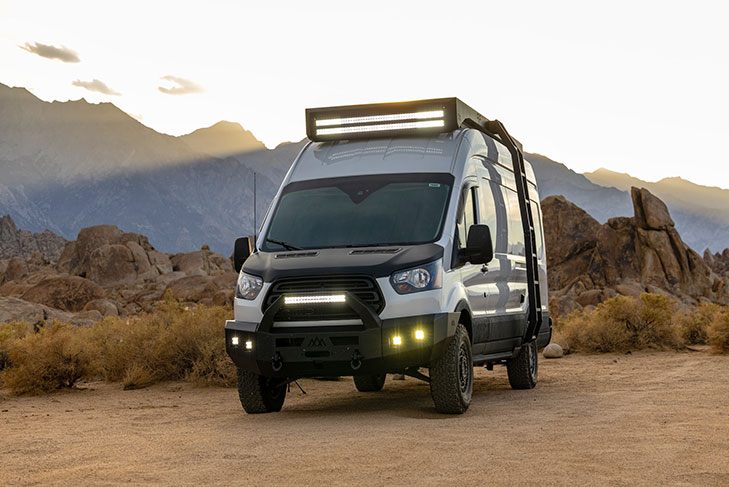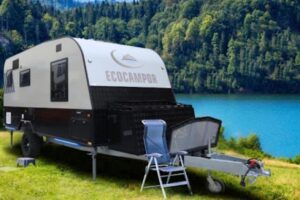Today I’m going to dive into a broad explanation of RV power systems. I’ll introduce some of the main components found in electrical systems, what types of power are utilized in campers, and where to source that power.
RV Electrical Systems
Understanding how electrical systems are constructed and the ways in which various electrical components in an RV interact with each other is the quickest way to gain a basic understanding of camper power systems.
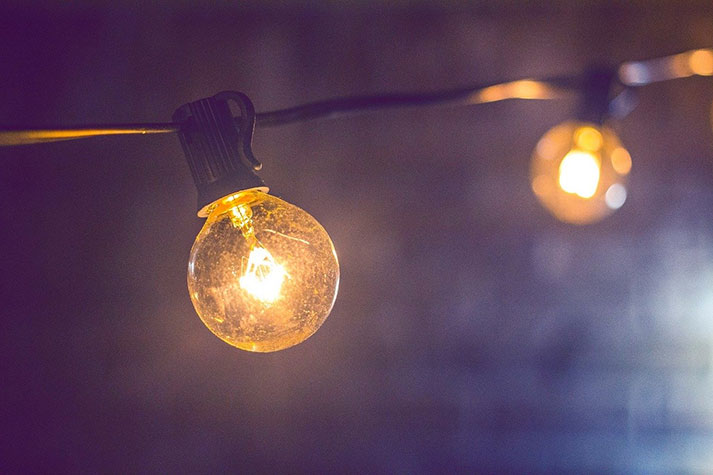
AC vs DC Power
Almost every single RV on the road uses a combination of alternating current and direct current power to run its appliances. Utilizing two types of power diversifies what kinds of appliances can be used in an RV, and how much energy these appliances need to operate efficiently. This, in the long run, leads to an increase in overall energy efficiency and money savings.
Alternating Current
Alternating current (AC) power is used for any appliance that requires a large amount of energy. Microwaves, water heaters, and air conditioners are the most common consumers of AC power in a camper. Additionally, standard wall outlets (just like the outlets in a house) are supplied with AC power.
AC circuits in RVs are typically designed for 120-volt alternating current power. It is called “alternating current” because the power running through an AC circuit rapidly fluctuates between its two peak voltages. In RVs these peak voltages are 120 volts and -120 volts.
This creates a wave-like pattern when the flow of energy is tracked on a graph with voltage on the Y-axis and time on the X-axis.
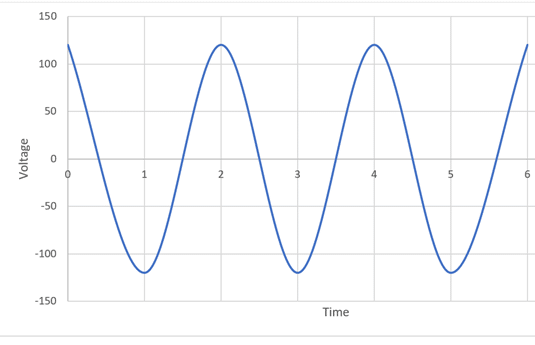
Direct Current
If you were able to follow along and understand alternating current power, then you’ll have no issue understanding direct current power.
RVs use 12-volt direct current power. It is called “direct current” because it has a constant, predictable, and direct pattern of flow. As 12V DC power flows, it sits at its maximum voltage and continues flowing in one direction without any fluctuations in that voltage.
If you learn best through visual aids, this video by the YouTube channel, The Engineering Mindset, has a great explanation of DC and AC power in it. The video itself is about how inverters work, with the AC vs DC explanation being within the first 5 minutes of the video.
Electrical Components in an RV
Electrical systems are constructed by carefully wiring together multiple electrical components and devices. Alone, these parts wouldn’t accomplish a whole lot, but together, they work to provide consistent, safe power for RVers to use.
The following parts are some of the most important pieces in an RV electrical system. If any one of these parts fails, an entire system can be crippled until that part is repaired or replaced.
Batteries
The batteries used in RVs are called “deep-cycle” batteries. These specialized batteries are specifically designed to safely discharge most of their stored power without harming the battery or other components in the system.
Whereas discharging a normal automotive battery on a regular basis will lead to a weak battery in need of replacing, deeply discharging a deep-cycle battery won’t shorten its overall lifespan. They are also referred to as “marine batteries” or “marine deep-cycle batteries” because of their long history of use by the marine industry.
RV batteries store and supply 12-volt DC power for use in either the DC or AC circuits in an RV. They are designed to supply a low, steady stream of power, whereas cranking batteries found in the engine compartment of a car are made for quick, high-powered bursts of energy.
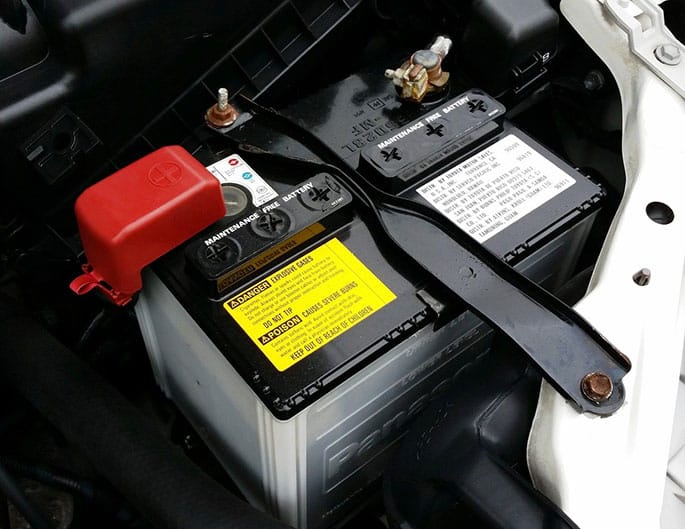
These days, most RVs are manufactured with modern lithium-iron phosphate batteries. These powerful and pricey batteries use lithium iron phosphate to store energy and can safely be discharged to as low as 20% of their total power capacity.
Inverter
Remember how I mentioned that an AC power circuit can use the 12V DC power stored and supplied by the batteries? Did you wonder how that process works?
Inverters are the magic solution to the AC vs DC power conundrum. An RV inverter takes 12V DC power and turns it into 120V AC power. Without an inverter, RVs would only be able to use 120V appliances while directly connected to a 120-volt AC power source like shore power.
Inverters accomplish the conversion of DC to AC by rapidly switching the direction of the DC input. This rapid, sustained direction change simulates the shape of an AC power output and allows AC devices to utilize that power as an energy source.
(Still confused? Keep watching the video above, it touches on some of this.)
Converter
A converter has a very similar (but slightly different) job to an inverter. Converters take the 120V power that is supplied by shore power connections at houses or power hookups at RV parks and alter the voltage so that it can be stored in the battery bank. Without converters, RVs have no ability to store incoming 120V power. This is why they are sometimes referred to as “battery chargers”.
Converters do not actually charge the batteries, but they do play a crucial role in ensuring batteries do get charged when the rig is hooked to power.
Breaker Box
Just like houses, RVs have breaker boxes. A breaker box is a component in a camper that distributes AC power to the various 120-volt circuits in the rig.
Have you ever had a ceiling light or outlet in your kitchen stop working, and to fix it you had to flip a switch on the big electrical panel located outside or in the garage? That big electrical panel is your house’s breaker box, and its job is to ensure the wires in your house do not melt from a surge of power.
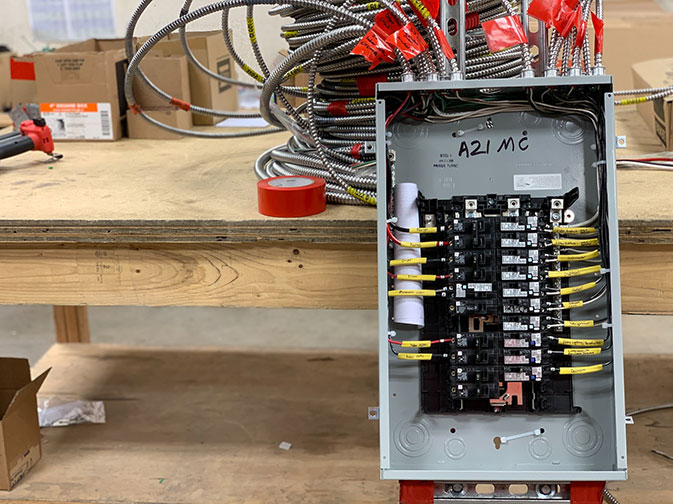
Just like in a house, RV breaker boxes protect the wiring in your rig from being fried due to unpredictable surges in power. AC power is sent to the breaker box from the inverter and then distributed to each appliance or outlet in the AC system.
DC Fuse Block
The DC fuse block functions in almost an identical way to a breaker box. The big difference is that the DC fuse block deals with, big surprise, DC power. While a breaker box has switches, fuse blocks have fuses installed for each circuit. These fuses will burn out if they encounter a power surge, and protect the wiring in your van from damage due to that power surge.
Sources of Power
RVs have three common sources of power:
- Shore power
- Generators
- Solar panels
Remember that an RV battery bank provides power, but is not a source of power. Batteries do not generate or create energy. They simply store energy that has been supplied to them from an external source.
Shore Power
Shore power derives its name from the nautical world. Boats with electrical systems must recharge their marine batteries after an extended amount of time at sea. To accomplish this, their electrical system is connected to power from the shore, or shore power.

RV electrical systems follow the same basic principle. After a trip or any event that lowers the charge on a battery bank, the quickest and most reliable way to recharge is via shore power. Shore power connections are traditionally located on the exterior of a rig and supply 120-volt AC power.
Keep an eye out for campers parked in driveways while driving around residential neighborhoods. If you see an extension cord running from the house to a port on the side of the camper, that’s shore power. Power hookups at RV parks are also called shore power.
Generators
Visit any RV park or popular boondocking location and you are likely to see a fair number of generators in use. Power generators are a safe and reliable way to provide a camper with energy to run appliances or recharge batteries. They convert chemical energy stored in liquid fuel such as gas or diesel into electrical energy that can be used in any number of applications.
Motorhomes and large fifth-wheel travel trailers usually have built-in generators while small travel trailers do not. Trailer owners typically have to purchase a portable generator as an aftermarket piece of equipment.
Solar Panels
Large, permanently installed solar panel arrays are becoming increasingly popular in the RV world. After the initial investment, harnessing renewable solar energy to power their camper will save any RVer a decent amount of money and help the planet out too.
Solar panels generate DC energy that can be stored in RV batteries with no need to interact with a converter or inverter. The only electrical component the energy passes through on its way to the batteries is called a solar charge controller.
A charge controller is a device that regulates the flow of energy between the solar panels and the battery bank. Without a charge controller, solar panels have the potential to overcharge and damage batteries. There can also be situations in which the solar panels leech energy out of the batteries, slowly draining them over time.
These are two of many potential electrical problems an RVer can face if a system is built improperly. If you install your own solar panels, do not forget to throw a charge controller in the mix.
Portable solar generators exist for those not looking to permanently install a panel array on their camper. Portable solar units are a bit costly but can be used in numerous situations that require AC or DC power. Every friend of mine that has invested in a portable solar panel system has ranted and raved about how much they love them.
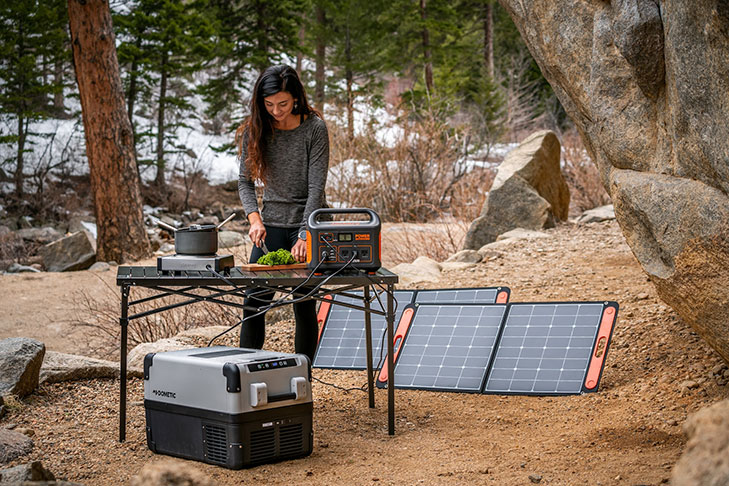
Recently, a couple I know purchased an expandable travel trailer for their weekend getaways. These people are hardcore and plan on using this trailer for camping almost every weekend, be it summer or winter. For powering their new rig, they invested in a large, high-quality portable solar generator and have yet to see it fall short.
Propane as An Alternative to Electricity
Back in the early days of RVing, many RV appliances were designed to operate using propane instead of electricity. Many modern versions of these same appliances are available today and can be purchased and used as a way to reduce the amount of electricity needed to power a rig.
Refrigerators, cooktops, and water heaters are just a few of the appliances in a camper that can run using propane. Most motorhomes and travel trailers utilize hybrid power systems. These hybrids have electrical systems to power some of their RV equipment and appliances, and propane to “power” the rest.
It is less common to see home-built camper vans with an integrated propane system. In my two years working as an RV conversion technician, I never installed propane lines in a van. We solely installed solar panels, shore power ports, and large battery banks to power our builds.

Frequently Asked Questions
Check out what other RV owners are asking us.
Do RVs supply their own power?
No, RVs do not supply their own power. Power is supplied to an RV via shore power, a generator, or solar power systems. This power is stored in the RV’s battery bank for future use.
Why do RVs need AC and DC power?
Modern-day electronics utilize either AC or DC power. Smaller electronics that require a less powerful flow of energy use DC power, while large, power-hungry appliances use AC power. In order for RV owners to use any and all electronics on the market, RVs need to offer both types of power.
Does an RV need to be hooked up to power?
RVs need to be hooked up to power when their battery bank is discharged too low. A battery bank with a low charge does not have the juice necessary to keep all the appliances in an RV running. Hooking an RV up to shore power via a house or generator will allow the RV to run its appliances and charge the batteries.
In this technologically advanced world, we are living in, RV electrical systems can be constructed to accommodate any individual’s unique lifestyle. From simple systems for little teardrop trailers to hefty, powerful systems for 4×4, off-grid beasts, anything is possible these days.
I hope this article has helped you wrap your head around the basics of RV power. If you are curious to learn more, check out the catalog of articles I have written on this topic for the adventure-camper manufacturer, Ecocampor. There’s a lot of great content there.
Happy camping!

